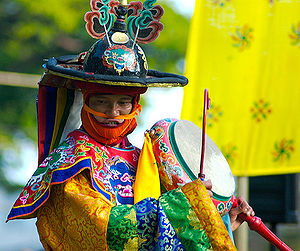- Cham dance
-
The cham dance (Tibetan and Dzongkha: འཆམ་; Wylie: 'cham),[2][3] also spelled tscham or chaam, is a lively masked and costumed dance associated with some sects of Buddhism, and is part of Buddhist festivals. The dance is accompanied by music played by monks using traditional Tibetan instruments. The dances often offer moral instruction relating to compassion for sentient beings and are held to bring merit to all who perceive them.[1][4]
Cham dances are considered a form of meditation, and an offering to the gods. The leader of the cham is typically a musician, keeping time using some percussion instrument like cymbals, the one exception being Dramyin Cham - where time is kept using dramyin.
Contents
Cham content
Chams often depict incidents from the life of Padmasambhava, the 9th century Nyingmapa teacher and other saints.[5]
The great debate of the Council of Lhasa between the two principal debators or dialecticians, Mo Ho Yen and Kamalaśīla is narrated and depicted in a specific cham dance once held annually at Kum-Bum Dshamba Ling, Tibet.[6]
Localities
Bhutan
In Bhutan, the dances are performed during an annual religious festival known as Tsechu, which is held in each district. Only monks or male members of the Royal Academy of Performing Arts are allowed to perform a cham dance in Bhutan.[5]
China
Tibetans in China usually perform the cham dance to large audiences during the Monlam Prayer Festival.[7]
India
Dances are performed in Sikkim during cultural and religious festivals.
See also
References
- ^ a b Pearlman, Ellen (2002). Tibetan Sacred Dance: a Journey into the Religious and Folk Traditions. Inner Traditions / Bear & Co. pp. 21, 32, 180. ISBN 0892819189. http://books.google.co.uk/books?id=JX-gKEJPszwC. Retrieved 2011-10-16.
- ^ "༈ རྫོང་ཁ་ཨིང་ལིཤ་ཤན་སྦྱར་ཚིག་མཛོད། ༼འཆ-༽ [Dzongkha-English Dictionary: "'CHA"]". Dzongkha-English Online Dictionary. Dzongkha Development Commission, Government of Bhutan. http://www.dzongkha.gov.bt/online/dictionaries/dz-en-dict/Contents/06-06-_CHA.html. Retrieved 2011-11-11.
- ^ "Tibetan-English-Dictionary of Buddhist Teaching & Practice". Diamond Way Buddhism Worldwide. Rangjung Yeshe Translations & Publications. 1996. http://www.diamondway-buddhism.org/diction/diction.htm. Retrieved 2011-11-11. entry: 'cham.
- ^ Clements, William M. (2006). "The Greenwood Encyclopedia of World Folklore and Folklife: Southeast Asia and India, Central and East Asia, Middle East". Greenwood Press. pp. 106–110. ISBN 0313328498. http://books.google.com/books?id=ZvrWAAAAMAAJ. Retrieved 2011-10-16.
- ^ a b Dancing on the demon's back: the dramnyen dance and song of Bhutan, by Elaine Dobson, John Blacking Symposium: Music, Culture and Society, Callaway Centre, University of Western Australia, July 2003
- ^ Roccasalvo, Joseph F.(1980). 'The debate at bsam yas: religious contrast and correspondence.' Philosophy East and West 30:4 (October 1980). The University of Press of Hawaii. Pp.505-520. Source: [1] (accessed: December 17, 2007)
- ^ "Backgrounder: Monlam Prayer Festival". Focus on Tibet (Xinhua). 2010-02-28. http://tibet.news.cn/english/2010-02/28/c_13191476_2.htm. Retrieved 2011-02-02.
External links
Categories:- Tibetan culture
- Bhutanese culture
- Himalayan dances
- Dance in Tibet
- Buddhist practices
- Tibetan Buddhist practices
- Tibetan Buddhist art and culture
- Sacred dance
Wikimedia Foundation. 2010.

